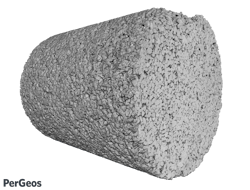Advances In microCT Scanning Enable a Faster, In-Depth Look Inside
What is better than an X-ray? How about an image that lets you look inside without having to destroy the object? That is the benefit of using micro-computed tomography (micro-CT). A micro-CT is a method of examining the inside of an object or structure without having to dissect or break said object.
With a micro-CT one can see how the interior of an object is allocated and where certain features are within the structure. This process has become useful in the analysis of composite and metal structures, geological cores, live animals, and in human analysis of bones. A new research project is looking to expand the reach of this technology by making the process more efficient and less labor-intensive than before.
The Xamflow Project
Xamflow is a micro-CT research project funded by Eurostars. Eurostars is a joint program between EUREKA and the European Commission, co-funded from the national budgets of 36 partnering states and countries, and by the European Union through Horizon 2020. The research team leader is Lucid Concepts from Switzerland, along with Scanco Medical (also of Switzerland) and the following Swedish institutions: KTH Royal School of Technology and Health, Capenta, Imacomp Consulting, and Linkoping University.
“Micro-CT scanning started with human biological materials, but nowadays anything can be scanned: synthetic materials, small animals, food, minerals, and fossils, for example,” says Tor Hildebrand, owner of project partner Imacomp AB. “Companies want to check the internal structure of their products without having to destroy their samples…with micro-CT scanning, you can check the microstructures in bone, porosity of food, and search for micro anomalies inside materials.”
The microCT scan above is from ThermoFisher scientific. The sandstone microCT highlighted here is an example of how X-ray micro-CT imaging is becoming an integral part of rock characterization processes. (Image credit: ThermoFisher)
Currently, the micro-CT process is complicated and time--consuming. It requires the scanning of multiple samples. The operator is required to switch between applications and tools, creating a slow process that incurs a high cost and introduces user error. To improve upon the process, the Xamflow project brings together several organizations that are experts in unique fields of study.
“We needed a company that knew the scanning process, a company that developed the hardware, a company that knew how to analyze the images, a company that could build the whole backend system, and a web developer,” says Hildebrand. “We were able to find a team of five different companies and institutes and bring them together to start this project.”
Lucid Concepts is an expert in handling visualization and image processing frameworks. Imacomp and Capenta oversaw the system architecture and the web application development, respectively. KTH Royal School of Technology and Health and Linkoping University ran the clinical analysis and distributed image processing. And Scanco Medical developed the imaging hardware for the program.
Introducing Automation
The Xamflow platform is essentially an automation tool for complex workflows. Workflow automation is a growing market that looks at different ways to streamline processes. By using automation, the system can handle the complete workflow of micro-CT examinations, from measurement and reconstruction to a full interactive or printed report with image analysis results, statistical analysis, and advanced imaging.
The software product’s unique workflow system will be able to handle very large data sets of up to 100 GB in the most efficient way possible. Xamflow combines the imaging hardware with the visualization and image processing frameworks, and introduces artificial intelligence to identify different tissues and structures inside the human body.
“When you examine and scan humans and animals, one of the most important things is to outline the internal organs and abnormalities—like tumors—in a process called segmentation,” says Hildebrand. “You need to extract the information from the scan in order to make a diagnosis or plan radiation treatment for example.
“To train the artificial intelligence networks, you need to do lots of scans and analyze a wide range of different tissue samples,” Hildebrand continues. “Xamflow is well-suited to support this type of scenario.” The research team has been recently awarded a second grant to advance its image processing and AI tools to find and identify structures in 3D images for clinical and research applications.


